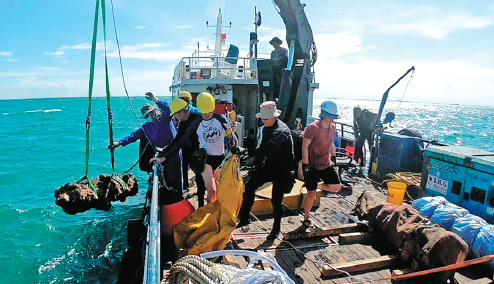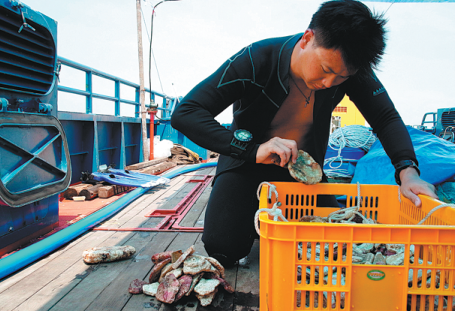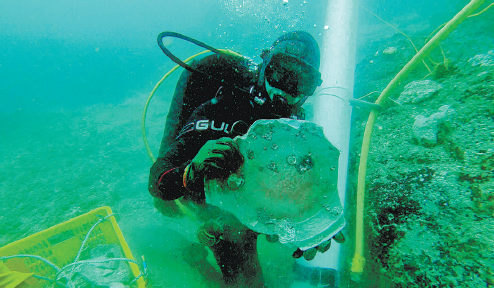Chinese relics found in wrecks off Singapore
Museums poised to showcase items recovered from the depths by divers
Two shipwrecks, one possibly dating to the 14th century and the other to the 18th, have been excavated in Singapore's waters, a first for the island nation and a groundbreaking development for its maritime heritage.
Both vessels, which carried Chinese ceramics as their primary cargo, were found off Pedra Branca, a rocky outcrop surrounded by shallow waters where ships throughout history have come to grief.
It is planned to display the artifacts in museums in Singapore.
Maritime archaeologist Michael Flecker, who supervised both excavations, described the first wreck as a "pretty remarkable" find, as it is from the Temasek period that spans the 1300s to the 1600s. Singapore appeared on maps during the Ming Dynasty (1368-1644) as Temasek.
While research may never determine the name of the first vessel, as there is nothing left of its hull, the second wreck has been identified as the India-built merchant vessel Shah Munchah, which sank in 1796 as it was returning to India from China.
On Dec 30, 2014, a Singapore-registered barge carrying two bulk loader cranes encountered bad weather on its way to Kuantan, the state capital of Pahang on the east coast of Malaysia, and ran aground off Pedra Branca.
Both cranes were at risk of toppling onto Pedra Branca's Horsburgh Lighthouse, which was built in 1851.
To prevent this happening, dynamite was attached to the cranes, which were blown up while two boats pulled them away from the lighthouse, scattering metal into the sea.
Commercial divers were hired to clear the metal from the area.
Flecker, a visiting fellow at the Institute of Southeast Asian Studies' archaeology unit, said that in 2015, while diving to retrieve the metal, project manager Ramdzan Salim and diver Ahmad Qamarulhazman found piles of ancient ceramic plates.
At about the same time, a 10-week-long archaeological dig was being carried out in Empress Place, Singapore.
Following media coverage of the findings, Salim and Qamarulhazman realized that some of the plates retrieved off Pedra Branca looked similar to artifacts discovered in Empress Place. They decided to hand the plates over to the institute for further research and safekeeping.
After the institute confirmed the plates were high-quality celadon ceramics from the 14th century, the National Heritage Board, or NHB, teamed up with the institute to conduct a survey at the Pedra Branca site, where a shipwreck was discovered in 2016.
After completing excavation work from the first wreck, the NHB and the institute conducted a survey off Pedra Branca, where they found a second shipwreck dating to the late 18th century. Efforts were made to excavate this wreck from 2019 to this year.
The first wreck was found about 100 meters northwest of the outcrop, the NHB and the institute announced on June 16, while the second was found 300 meters east of Pedra Branca.
Flecker said in an interview with The Straits Times that various Chinese ceramics formed the bulk of the haul from the first wreck, with some matching those previously unearthed in Singapore.
For example, Longquan greenware dishes from the first wreck match those unearthed earlier at Fort Canning, with both sets bearing a double-fish motif.
"From Fort Canning, there is a plate that is so similar you might almost be tempted to think they used the same stamp (to produce the motif)," Flecker said.
With research continuing, he said the find would be especially significant if it could be determined that the vessel was going to call at Singapore, which he believes it was.
More research will be carried out to improve knowledge of maritime trading in the region during the 14th century.
Flecker, who has more than 30 years of maritime archaeological experience, said the Yuan Dynasty (1271-1368) blue-and-white ceramic haul from the first wreck is the largest recovered from a shipwreck to date.
"There have only been three other (wreck) sites with Yuan blue-and-white porcelain anywhere in the world, and in much smaller quantities," he said, adding that it was clear from the primary cargo of both vessels, which comprised Chinese ceramics, that they were loaded in China.
The Shah Munchah wreck site yielded a much wider range of artifacts-from instruments to cannon.
Among the surprising finds were percussion instruments, including a tambourine and a coconut shaker with a handle, Flecker said.
Wooden-frame parasols, metal betel nut cutters and a large number of figurines were also retrieved by divers.
The heaviest discoveries were four anchors-as long as 5 meters and each weighing 2.5 metric tons-and nine cannon, which were removed from the seabed by a craned vessel.
Flecker said, "The anchors are suitable for very large sailing vessels, so it's a good find and well worth getting them up for conservation."
The nine cannon, which he said are representative of those used at the time, were typically mounted on ships employed by the East India Company in the 18th and early 19th centuries. The weapons were used for defense and signaling.
The artifacts are stored at facilities managed by the NHB and the institute, where they will be cleaned, preserved and catalogued.
Flecker said of the Shah Munchah: "Had she survived another 23 years, she would almost certainly have called at the re-established port of Singapore. Her incredibly diverse cargo provides great insights into the type of goods that would have been exchanged and purchased by the new inhabitants of this fledgling city."
The shipwrecks, the first to be found in Singaporean waters, will contribute to a better understanding of the nation's maritime past. As no claims had been lodged for the wrecks and their artifacts at the end of the stipulated notice period of one month, they have been claimed by the authorities in Singapore.
Although it is highly likely that more wrecks lie on the seabed in Singapore's waters, some of these have been covered by reclamation work, while heavy maritime traffic in the Singapore Strait makes locating others a hazardous business.
Yeo Kirk Siang, director of heritage research and assessment for the NHB, said, "As an island that has been serving as the gateway to Asia for centuries, Singapore today is the legacy of our rich maritime heritage.
"We will continue to research the significance of the artifacts and find ways to promote knowledge, enabling more people to learn about them and Singapore's maritime history."
The NHB plans to display the artifacts in museums in Singapore from the end of this year, while the institute will likely publish related findings in reports and research papers.


















